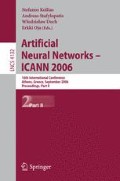Abstract
This paper demonstrates how attended stimuli may be localized even if they are complex items composed of elements from several different feature maps and from different locations within the Selective Tuning (ST) model. As such, this provides a step towards the solution of the ‘binding problem’ in vision. The solution relies on a region-based winner-take-all algorithm, a definition of a featural receptive field for neurons where several representations provide input from different spatial areas, and a localized, distributed saliency computation specialized for each featural receptive field depending on its inputs. A top-down attentive mechanism traces back the connections activated by feed-forward stimuli to localize and bind features into coherent wholes.
Access this chapter
Tax calculation will be finalised at checkout
Purchases are for personal use only
Preview
Unable to display preview. Download preview PDF.
References
Tsotsos, J.K.: A Complexity Level Analysis of Vision. Behavioral and Brain Sciences 13, 423–455 (1990)
Tsotsos, J.K., Culhane, S., Wai, W., Lai, Y., Davis, N., Nuflo, F.: Modeling visual attention via selective tuning. Artificial Intelligence 8, 1–2, 507–547 (1995)
Rosenblatt, F.: Principles of Neurodynamics: Perceptions and the Theory of Brain Mechanisms. Spartan Books (1961)
Tsotsos, J.K.: The Complexity of Perceptual Search Tasks. In: Proc. International Joint Conference on Artificial Intelligence Detroit, pp. 1571–1577 (1989)
Treisman, A., Gelade, G.: A feature-integration theory of attention. Cognitive Psychology 12, 97–136 (1980)
Felleman, D., Van Essen, D.: Distributed Hierarchical Processing in the Primate Visual Cortex. Cerebral Cortex 1, 1–47 (1991)
von der Malsburg, C.: The correlation theory of brain function, Internal Rpt. 81-2, Dept. of Neurobiology, Max-Planck-Institute for Biophysical Chemistry, Göttingen, Germany (1981)
Gray, C.M.: The Temporal Correlation Hypothesis of Visual Feature Integration, Still Alive and Well. Neuron 24(1), 31–47 (1999)
Desimone, R., Duncan, J.: Neural mechanisms of selective visual attention. Annual Reviews of Neuroscience 18, 193–222 (1995)
Itti, L., Koch, C.: Computational modelling of visual attention. Nature Reviews Neuroscience 2, 194–204 (2001)
Riesenhuber, M., Poggio, T.: Are Cortical Models Really Bound by the “Binding Problem”? Neuron 24(1), 87–93 (1999)
Mehta, A.D., Ulbert, I., Schroeder, C.E.: Intermodal Selective Attention in Monkeys. I: Distribution and Timing of Effects across Visual Areas. Cerebral Cortex 10(4), 343–358 (2000)
Connor, D.O., Fukui, M., Pinsk, M., Kastner, S.: Attention modulates responses in the human lateral geniculate nucleus. Nature Neuroscience 5(11), 1203–1209 (2002)
Tsotsos, J.K., Liu, Y., Martinez-Trujillo, J., Pomplun, M., Simine, E., Zhou, K.: Attending to Motion. Computer Vision and Image Understanding 100(1-2), 3–40 (2005)
Tsotsos, J.K., Culhane, S., Cutzu, F.: From Theoretical Foundations to a Hierarchical Circuit for Selective Attention. In: Braun, J., Koch, C., Davis, J. (eds.) Visual Attention and Cortical Circuits, pp. 285–306. MIT Press, Cambridge (2001)
Tsotsos, J.K.: An Inhibitory Beam for Attentional Selection. In: Harris, L., Jenkin, M. (eds.) Spatial Vision in Humans and Robots, pp. 313–331. Cambridge University Press, Cambridge (1993); (papers from York University International Conference on Vision, June 1991, Toronto)
Fukushima, K.: A neural network model for selective attention in visual pattern recognition. Biological Cybernetics 55(1), 5–15 (1986)
Author information
Authors and Affiliations
Editor information
Editors and Affiliations
Rights and permissions
Copyright information
© 2006 Springer-Verlag Berlin Heidelberg
About this paper
Cite this paper
Tsotsos, J.K. (2006). Localization of Attended Multi-feature Stimuli: Tracing Back Feed-Forward Activation Using Localized Saliency Computations. In: Kollias, S., Stafylopatis, A., Duch, W., Oja, E. (eds) Artificial Neural Networks – ICANN 2006. ICANN 2006. Lecture Notes in Computer Science, vol 4132. Springer, Berlin, Heidelberg. https://doi.org/10.1007/11840930_49
Download citation
DOI: https://doi.org/10.1007/11840930_49
Publisher Name: Springer, Berlin, Heidelberg
Print ISBN: 978-3-540-38871-5
Online ISBN: 978-3-540-38873-9
eBook Packages: Computer ScienceComputer Science (R0)

